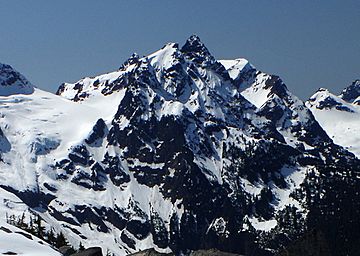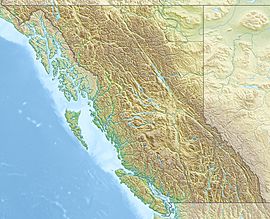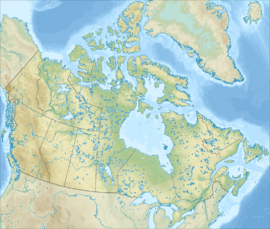Stewart Peak (British Columbia) facts for kids
Quick facts for kids Stewart Peak |
|
|---|---|
 |
|
| Highest point | |
| Elevation | 2,238 m (7,343 ft) |
| Prominence | 118 m (387 ft) |
| Geography | |
| Location | British Columbia, Canada |
| Parent range | North Cascades |
| Topo map | NTS 92 H/4 |
| Climbing | |
| First ascent | 1884 by E. Knight, D. Walker |
| Easiest route | Scrambling via south side |
Stewart Peak is a tall mountain in southwestern British Columbia, Canada. It stands about 2,238 meters (7,343 feet) high. This mountain is part of the Cheam Range, a group of mountains located near the city of Chilliwack. Stewart Peak is found west of The Still Peak and east of Baby Munday Peak.
How Stewart Peak Got Its Name
Stewart Peak is named after one of the partners from an engineering company. This company was called Foley, Welch and Stewart. They were important because they built and ran the Lucky Four Mine, which was located close to the peak. You might notice that other mountains nearby are also named after the other partners: Foley Peak and Welch Peak.
The Story of the Land: Geology
The Cascade Mountains, where Stewart Peak is located, were formed millions of years ago. This happened during a time called the late Eocene Epoch. The North American Plate (a huge piece of Earth's crust) slowly moved over the Pacific Plate. This movement caused many volcanic eruptions and created new rocks.
Also, small pieces of Earth's crust, called terranes, came together. These pieces helped form the North Cascades about 50 million years ago.
Later, during the Pleistocene period, which was over two million years ago, huge sheets of ice called glaciers moved across the land. These glaciers moved forward and backward many times. As they moved, they scraped away the land, leaving behind piles of rock. The "U"-shaped valleys you see in the mountains today were carved out by these ancient glaciers.
Over time, the land also pushed upward (this is called uplift). Large cracks in the Earth's crust, known as faults, also shaped the area. These processes, along with the glaciers, created the tall peaks and deep valleys of the North Cascades. The North Cascades are known for their rugged landscape, with sharp peaks, granite spires, and deep valleys carved by ice.
Weather on the Mountain
Most of the weather that affects Stewart Peak comes from the Pacific Ocean. These weather systems, called weather fronts, travel east towards the Cascade Range. When these fronts reach the tall peaks of the Cascade Range, they are forced to rise. As the air rises, it cools down and drops its moisture. This process is called Orographic lift.
Because of this, the western side of the North Cascades gets a lot more rain or snow. This is especially true during the winter months, when heavy snowfall is common. In winter, the weather is often cloudy. However, during the summer, high-pressure systems over the Pacific Ocean become stronger. This often means that summer days on Stewart Peak are clear with very few clouds.



